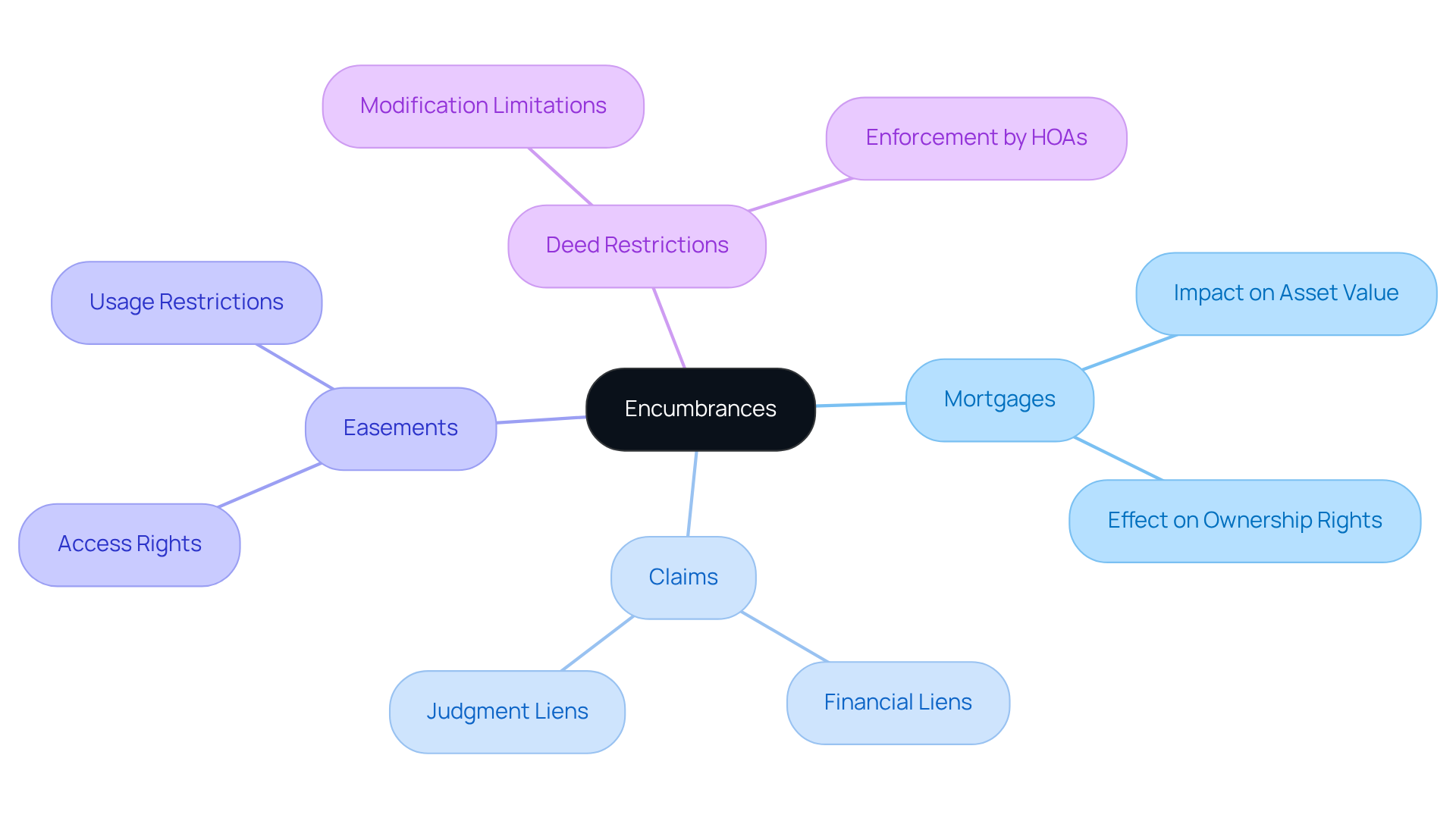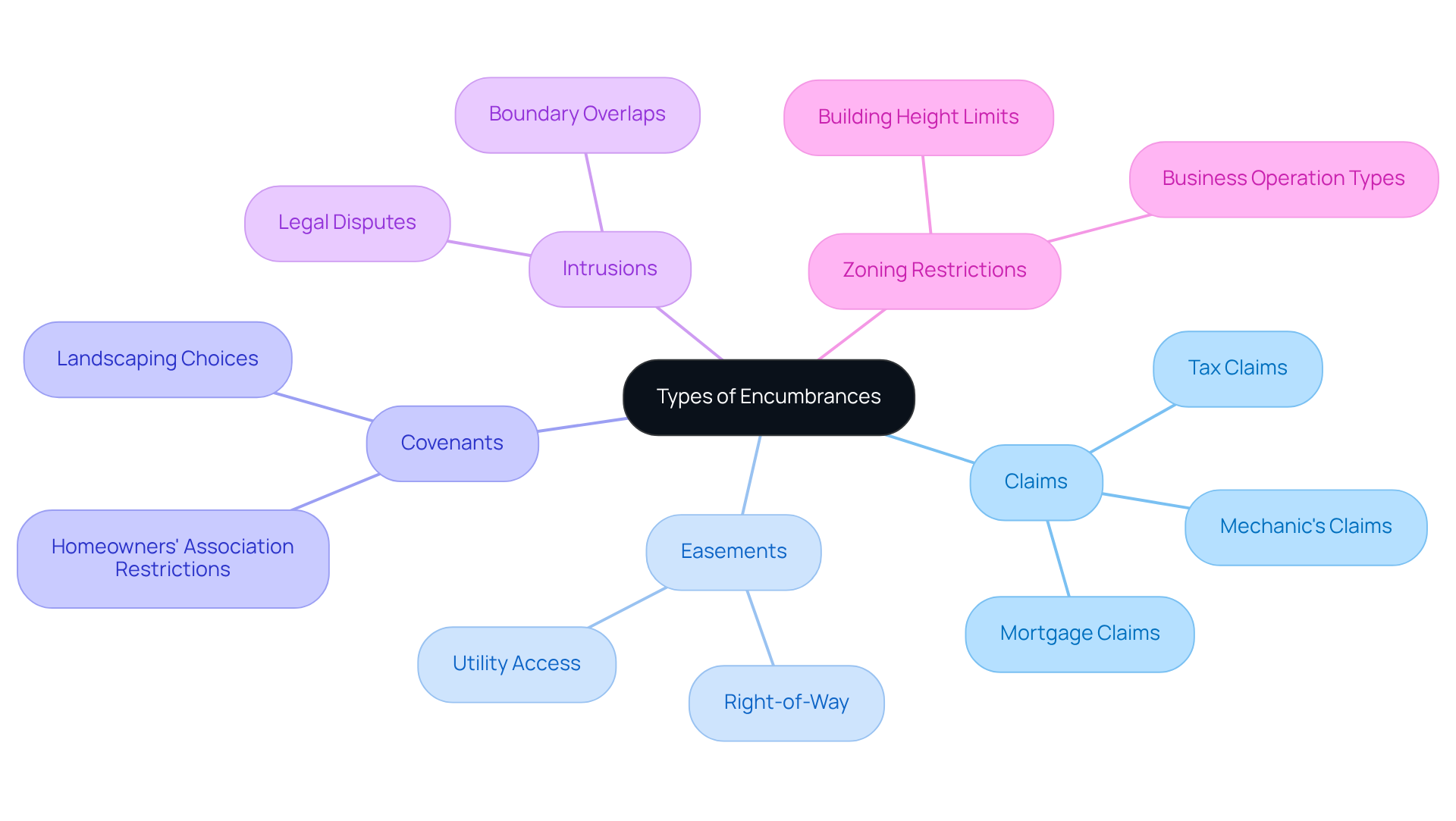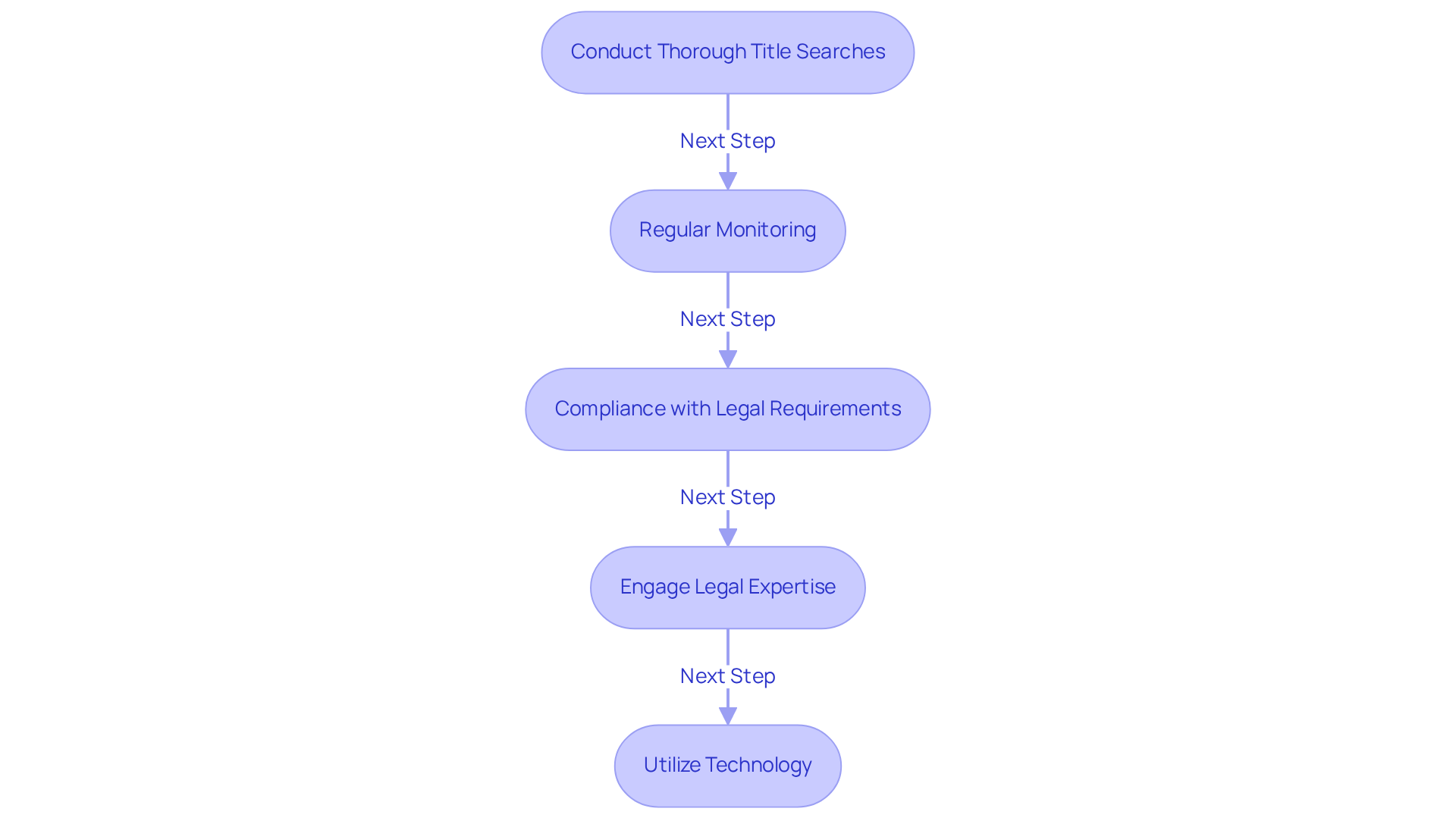Overview
This article delves into the critical understanding of encumbrances in research, particularly their types and management strategies, which are essential for real estate professionals. Recognizing various encumbrances—such as liens, easements, and zoning restrictions—is vital for accurately evaluating property value and ownership rights. Furthermore, it outlines effective management strategies, including:
- Comprehensive title searches
- Adherence to legal requirements
to mitigate the risks associated with these burdens. By emphasizing these aspects, the article reinforces the importance of diligent research and proactive management in real estate transactions.
Introduction
Understanding the complexities of encumbrances is crucial for anyone involved in real estate; these legal claims can significantly restrict an owner's rights and the asset's marketability. By delving into the various types of encumbrances—such as liens, easements, and covenants—real estate professionals can navigate the potential pitfalls that may arise during transactions more effectively. Furthermore, the question remains: how can one effectively manage these burdens to ensure compliance and safeguard investments? This article explores the nuances of encumbrances, offering valuable insights and strategies for successful management in the ever-evolving landscape of real estate.
Define Encumbrances: Key Concepts and Importance
A burden represents a , thereby restricting the owner's ability to transfer or utilize the asset freely. These burdens manifest in various forms, including:
- Mortgages
- Claims
- Easements
- Deed restrictions
For realty professionals, is vital, as these claims can profoundly . For instance, or outstanding taxes can significantly diminish a , complicating transactions and deterring potential buyers.
Furthermore, understanding encumbrances in research is essential for in dealings, as these burdens can affect not only the asset's value but also the owner's rights and ability to secure financing.
Case studies highlight the necessity for buyers to remain vigilant in understanding encumbrances in research related to a real estate asset, as these claims can shape the terms of ownership and future utilization.

Explore Types of Encumbrances: Liens, Easements, and More
involves categorizing them into several key types, each carrying distinct implications for property ownership and use.
- Claims: A claim signifies a in a borrower's asset until the debt is resolved. Typical types consist of mortgage claims, which secure loans against the asset, tax claims imposed by the government for unpaid taxes, and mechanic's claims, arising from unpaid work on the asset. These liens can significantly impact the marketability of the asset, as they must be resolved before a clear title can be transferred.
- Easements: An easement grants a third party the right to use a portion of the land for specific purposes, such as utility access or right-of-way. While easements enable essential services, they can limit the owner's capacity to alter or enhance the land, potentially affecting its worth and usability.
- Covenants: These are legally binding agreements that impose restrictions on how real estate can be used, often found in homeowners' association agreements. Covenants can dictate permissible modifications, landscaping choices, and even the types of structures that can be built, thereby influencing the overall character of a neighborhood.
- Intrusions: Intrusions occur when a structure or enhancement extends beyond the boundary line, leading to potential disagreements with adjacent landowners. Such situations can complicate real estate transactions and necessitate legal resolution.
- Zoning Restrictions: Local government regulations can impose , affecting everything from building height to the types of businesses that can operate in a given area. Understanding encumbrances in research is essential for evaluating a real estate's potential and worth.
must navigate these obstacles carefully, with an understanding of encumbrances in research, as they can introduce significant risks and complexities into property transactions. Insights from industry experts emphasize the importance of to uncover any existing liens, easements, or covenants before proceeding with a purchase. By leveraging , such as those offered by Parse AI, professionals can streamline their research processes, ensuring they make informed decisions that mitigate potential liabilities.

Manage Encumbrances: Reporting and Compliance Strategies
Effectively managing encumbrances necessitates a multifaceted approach:
- Conduct Thorough es: Prior to acquiring any real estate, it is imperative to execute a . This critical process reveals existing hindrances, allowing purchasers to engage in related to the potential risks and obligations associated with the asset. The average cost of a title search ranges from $75 to $250, underscoring the financial implications of this vital step.
- Regular Monitoring: Continuous oversight of obligations is essential. This involves maintaining up-to-date records of liens, easements, and other restrictions that could impact the property's value and usability. Regular assessments can help identify any changes that may influence ownership or usability.
- Compliance with : All liabilities must be accurately documented and comply with local laws and regulations. This includes filing necessary paperwork and obtaining required approvals for any alterations. As noted by the American Bar Association, "A title search is a crucial step in the real property transaction process, as it assists in identifying possible risks and issues that may affect the buyer's ownership of the property."
- : Partnering with legal professionals who specialize in real estate is essential for navigating complex property issues. Their expertise can facilitate dispute resolution and ensure adherence to relevant regulations.
- Utilize Technology: The implementation of , such as , can significantly . Parse AI's commitment to continuous improvement and collaboration with land service experts enables more accurate , ultimately saving time and resources.
By adopting these strategies, real estate professionals can enhance their understanding of encumbrances in research, ensuring compliance and enabling smoother transactions.

Conclusion
Understanding encumbrances is crucial for anyone involved in real estate, as these legal claims or obligations can significantly affect the value and usability of an asset. By grasping the nature of various encumbrances—such as liens, easements, covenants, and zoning restrictions—property owners and investors can make informed decisions that safeguard their interests and enhance marketability.
The article delves into the types of encumbrances, emphasizing the need for thorough research and management strategies. Conducting comprehensive title searches is essential, and maintaining regular monitoring of obligations is vital. Furthermore, seeking legal expertise can help navigate potential complexities. Additionally, leveraging technology tools can streamline the process, ensuring compliance and mitigating risks associated with property transactions.
Ultimately, understanding and managing encumbrances is not merely a procedural necessity but a strategic advantage in real estate. By prioritizing due diligence and employing effective management strategies, stakeholders can protect their investments and foster smoother transactions. Embracing these practices will lead to more informed, confident decision-making in the ever-evolving landscape of real estate.
Frequently Asked Questions
What are encumbrances in real estate?
Encumbrances are legal claims or obligations against an asset that restrict the owner's ability to transfer or utilize the asset freely.
What are some common types of encumbrances?
Common types of encumbrances include mortgages, claims, easements, and deed restrictions.
Why is it important for realty professionals to understand encumbrances?
Understanding encumbrances is vital for realty professionals because these claims can significantly impact asset value and ownership rights, affecting marketability and complicating transactions.
How can financial obligations like liens or outstanding taxes affect a property?
Financial obligations such as liens or outstanding taxes can diminish a property's marketability, complicating transactions and deterring potential buyers.
How do encumbrances influence real estate decisions?
Encumbrances can affect an asset's value and the owner's rights, which is crucial for making informed decisions in real estate dealings, including securing financing.
What should buyers be vigilant about regarding encumbrances?
Buyers should remain vigilant in understanding encumbrances related to a real estate asset, as these claims can shape the terms of ownership and future utilization.




